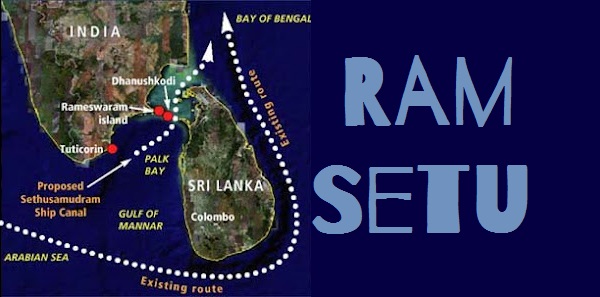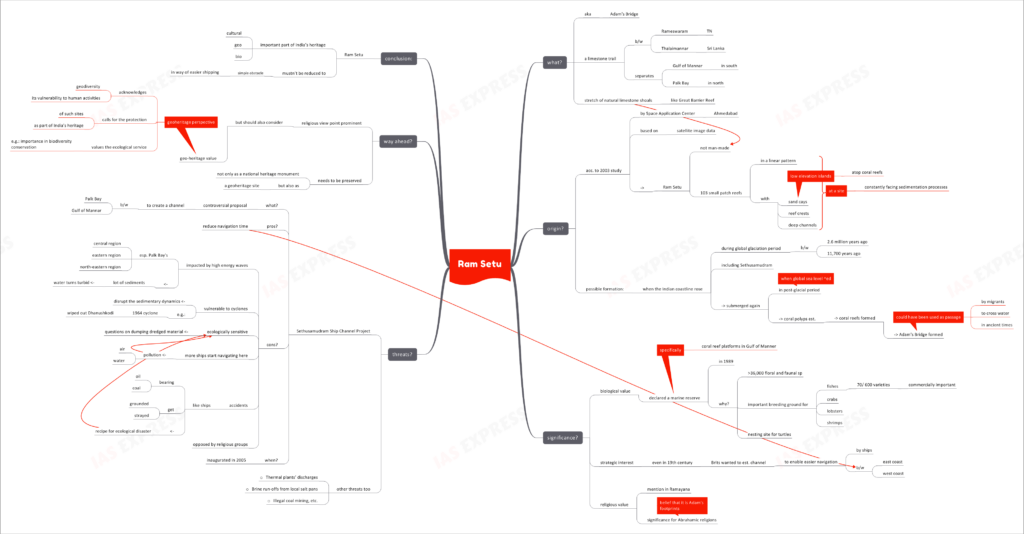Ram Setu- Origin, Significance and Threats

On November 10th, the apex court gave 4 weeks’ time to the central government to clarify its stand on a plea seeking ‘national heritage’ status for the iconic Ram Setu.

What is Ram Setu?
- Ram Setu or Adam’s Bridge is a limestone trail running between Rameswaram in Tamil Nadu and Thalaimannar in Sri Lanka.
- The Ram Setu, like Australia’s Great Barrier Reef, is a stretch of natural limestone shoals.
- This coral ridge separates the Gulf of Mannar in the south and the Palk Bay in the north.
How did it originate?
- In 2003, the Space Applications Center of Ahmedabad concluded that the feature isn’t man-made, based on satellite images.
- According to the researchers, it consists of 103 small patch reefs spread out in a linear pattern with sand cays, reef crests and deep channels.
- Cays/ keys are low-elevation islands sitting atop coral reefs.
- The Ram Setu is a geographical feature formed at a location that is constantly facing sedimentation processes.
- It could have been formed when the Indian coastline, including Sethusamudram, rose above the water during the global glaciation period (started some 2.6 million years ago and spanned till about 11,700 years ago).
- In the post-glacial period, the global sea levels rose steadily.
- On these newly submerged platforms, coral polyps took root and established reefs. Over time, these developed into the Ram Setu.
- Studies have suggested that these platforms were used in the ancient times by migrants to cross the waters.
Why is its significant?
- In 1989, the coral reef platforms in the Gulf of Manner was notified as a marine biosphere reserve.
- Over 36,000 floral and faunal species live in this area.
- It is an important breeding ground for fishes, crabs, shrimps, lobsters, etc. Some 70 of the 600 fish varieties recorded here are commercially important.
- The region is also favourable for turtles’ nesting.
- The site is of strategic interest too. Even as early as in the 19th century, the British considered dredging up a channel to enable large vessels navigate more easily between the west and east coasts.
- The Ramayana mentions a land bridge in the same region as the current-day Ram Setu. Believers hold it that it was built by Rama and his army to reach Sri Lanka.
- The Adam’s Bridge also holds significance for Abrahamic religions. The structure is believed to be Adam’s footprints from when he was expelled from paradise.
What are the threats?
- The Sethusamudram Ship Channel Project is a controversial proposal, inaugurated in 2005, to create a channel linking the Palk Strait and the Gulf of Mannar. The project sought to reduce the navigation time between India’s east and west coasts.
- Computer models suggest that the Palk Bay’s central, eastern and north-eastern stretches are often impacted by high energy waves. These regions receive a lot of sediment, rendering the waters turbid.
- The region is also vulnerable to cyclones and such storms disrupt the sedimentary dynamics. Notably, the 1964 cyclone wiped out the entire town of Dhanushkodi.
- Given the sensitive nature of the local terrestrial and marine ecosystems, finding suitable spots to dump the dredged materials from the SSCP could be a major challenge.
- If even more ships start navigating these waters, there will be corresponding increase in air and water pollution.
- Any accidents in the narrow channel, like a grounded or straying ship bearing oil/ coal, is a recipe for ecological disaster.
- The project is also opposed by religious groups, given the structure’s cultural significance.
- Apart from this project, the site is already facing threats from:
- Thermal plants’ discharges
- Brine run-offs from local salt pans
- Illegal coal mining, etc.
What is the way ahead?
- In the debates surrounding the Ram Setu, religious viewpoints often take up most of the spotlight. However, it is also important to consider the geo-heritage value of the Ram Setu.
- The geoheritage perspective acknowledges the geodiversity and its vulnerability to human activities.
- It calls for the protection of such sites as a part of the country’s heritage.
- It also values the ecological service rendered by the site’s abiotic factors, for instance, their importance in biodiversity conservation.
- The Ram Setu holds significant value for Indian cultural heritage as well as bio- and geo-heritage. Hence, it needs to be preserved, not only as a national heritage monument, but also as a geoheritage site.
Conclusion:
The Ram Setu is an important part of India’s cultural, bio- and geo-heritage. It mustn’t be reduced to a simple obstacle in the way of easier shipping.
Practice Question for Mains:
Discuss the significance of Ram Setu. Examine the case for the Sethusamudram Ship Channel Project to improve navigation in the region. (250 words)
If you like this post, please share your feedback in the comments section below so that we will upload more posts like this.

